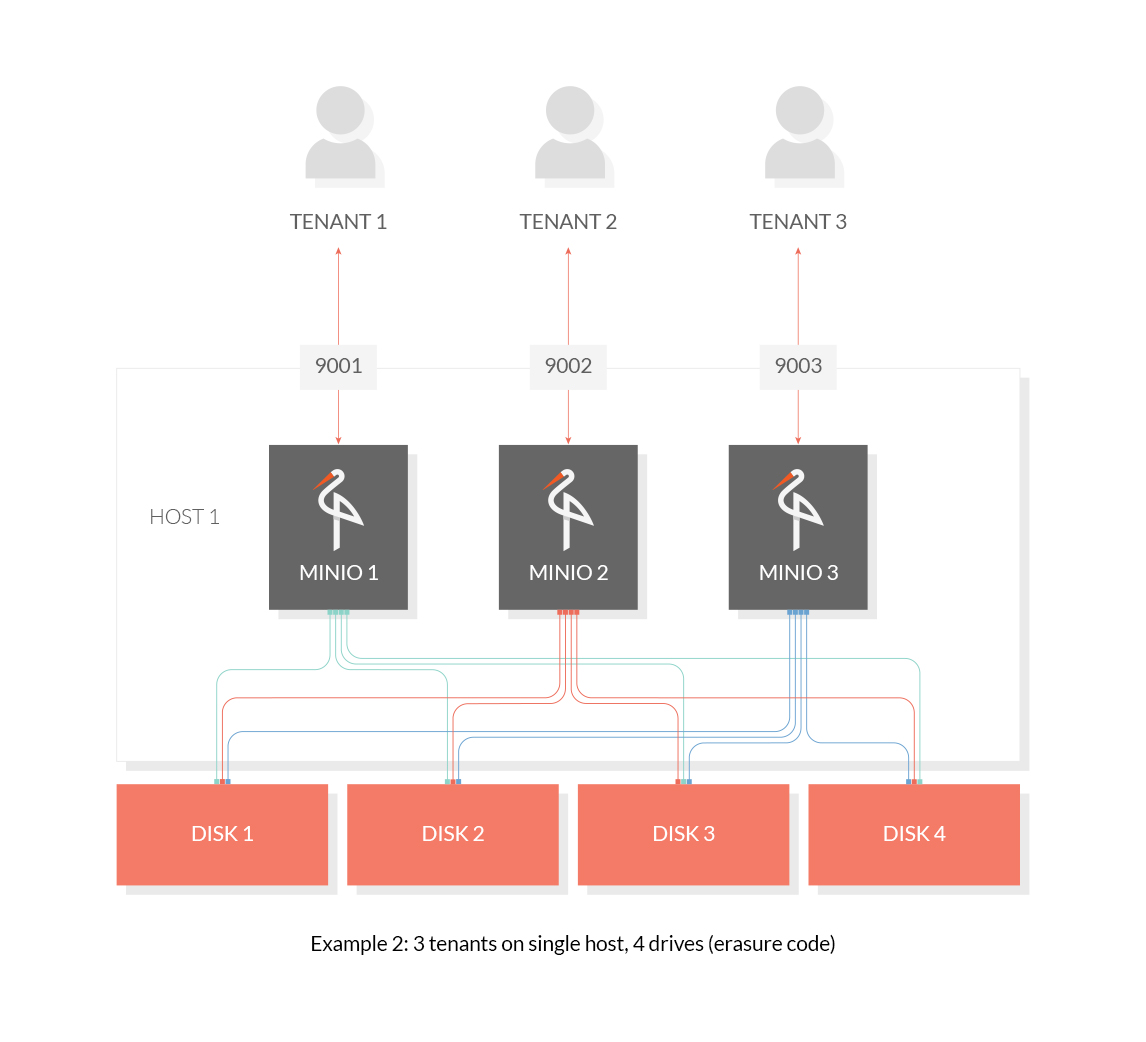一、概述
MinIO 是一个开源的对象存储服务器,用于存储和管理大规模的非结构化数据,例如图像、视频、日志文件、备份和容器镜像。MinIO 旨在提供高性能、高可用性、可扩展性和易用性的对象存储解决方案,适用于私有云、公共云和混合云环境。
以下是 MinIO 的主要特点和介绍:
-
开源和自由:
MinIO是一个开源项目,根据Apache License 2.0许可证发布,这意味着您可以免费使用、修改和分发它。 -
对象存储:
MinIO是一种对象存储系统,它使用存储桶(buckets)来组织数据,每个存储桶包含多个对象。对象可以是各种文件、文档、媒体和其他非结构化数据。 -
高性能:
MinIO具有出色的性能,能够以高速处理大规模数据。它采用了分布式、并行和多线程处理技术,以支持高吞吐量和低延迟。 -
高可用性:
MinIO具有内置的冗余和故障转移功能,支持数据备份和多副本存储,以确保数据的持久性和高可用性。它还支持数据版本控制。 -
容器化:
MinIO可以轻松部署在容器化环境中,如Docker和Kubernetes。这使得它适用于云原生应用和容器化工作负载。 -
分布式扩展:
MinIO支持分布式架构,可以轻松扩展以适应不断增长的数据需求。您可以添加更多的MinIO实例以构建多节点集群。 -
S3 兼容:
MinIO提供了S3(Simple Storage Service) API兼容性,这意味着它可以与现有的S3客户端和应用程序集成,无需进行大规模修改。 -
安全性:
MinIO提供数据加密、身份验证和访问控制功能,以确保数据的保密性和完整性。它还支持SSL/TLS加密。 -
易用性:
MinIO的配置和管理非常简单,具有用户友好的命令行界面和Web管理控制台。它还有丰富的文档和活跃的社区支持。
MinIO 是一个功能强大且易于使用的对象存储解决方案,适用于各种应用,从数据备份和存档到大规模媒体存储和分析。它为云原生环境提供了一个强大的存储选项,并且由于其开源性质,广受开发者和组织的欢迎。
官方文档:https://min.io/docs/minio/linux/index.html
以前也写过蛮多 MinIO 的文章,可以参考以下:
- 高性能分布式对象存储——MinIO(环境部署)
- 高性能分布式对象存储——MinIO实战操作(MinIO扩容)
- 【云原生】Minio on k8s 讲解与实战操作
- 【大数据】通过 docker-compose 快速部署 MinIO 保姆级教程
- 【云原生】镜像仓库 Harbor 对接 MinIO 对象存储
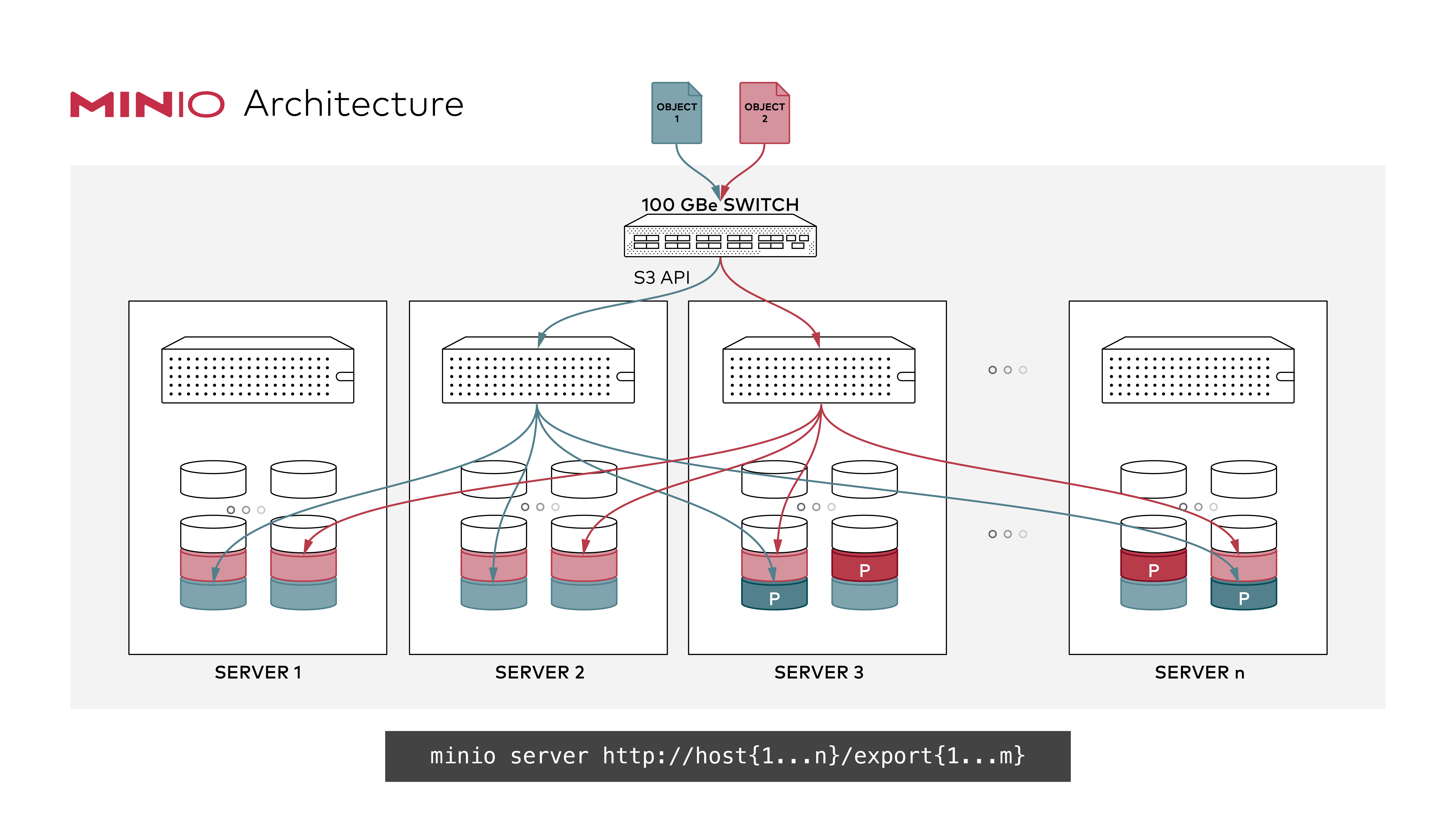
二、单机部署(单主机,多硬盘模式)
1)磁盘初始化
mkfs.xfs /dev/sdb -L DISK1
mkfs.xfs /dev/sdc -L DISK2
mkfs.xfs /dev/sdd -L DISK3
mkfs.xfs /dev/sde -L DISK4
mkdir /data{1..4}
vi /etc/fstab
# <file system> <mount point> <type> <options> <dump> <pass>
LABEL=DISK1 /data1 xfs defaults,noatime 0 2
LABEL=DISK2 /data2 xfs defaults,noatime 0 2
LABEL=DISK3 /data3 xfs defaults,noatime 0 2
LABEL=DISK4 /data4 xfs defaults,noatime 0 2
-
file systemLabel就是分区的标签,在最初安装系统是填写的挂载点就是标签的名字。使用设备名(例如:/dev/sdb)和label及uuid作为标识的不同。这里使用的是lable。 -
mount point挂载目录。 -
type文件系统类型,包括xfs、ext2、ext3、ext4、reiserfs、nfs、vfat等。 -
options文件系统的参数,参数如下:Async/sync:设置是否为同步方式运行,默认为asyncauto/noauto:当执行mount -a的命令时,此文件系统是否被主动挂载。默认为autorw/ro:是否以以只读或者读写模式挂载exec/noexec:限制此文件系统内是否能够进行"执行"的操作user/nouser:是否允许用户使用mount命令挂载suid/nosuid:是否允许SUID的存在Usrquota:启动文件系统支持磁盘配额模式Grpquota:启动文件系统对群组磁盘配额模式的支持Defaults:同事具有rw,suid,dev,exec,auto,nouser,async等默认参数的设置
-
dump是一个用来作为备份的命令参数值解释如下:0代表不要做dump备份1代表要每天进行dump的操作2代表不定日期的进行dump操作
2)创建服务启动用户并设置磁盘属主
groupadd -r minio-user
useradd -M -r -g minio-user minio-user
chown minio-user:minio-user /data{1..4}
3)下载 minio 安装包
wget https://dl.min.io/server/minio/release/linux-amd64/archive/minio-20231025063325.0.0.x86_64.rpm -O minio.rpm
sudo yum install minio.rpm -y
4)修改配置
vi /etc/default/minio
# MINIO_ROOT_USER and MINIO_ROOT_PASSWORD sets the root account for the MinIO server.
# This user has unrestricted permissions to perform S3 and administrative API operations on any resource in the deployment.
# Omit to use the default values 'minioadmin:minioadmin'.
# MinIO recommends setting non-default values as a best practice, regardless of environment.
MINIO_ROOT_USER=myminioadmin
MINIO_ROOT_PASSWORD=myminioadmin
# MINIO_VOLUMES sets the storage volumes or paths to use for the MinIO server.
# The specified path uses MinIO expansion notation to denote a sequential series of drives between 1 and 4, inclusive.
# All drives or paths included in the expanded drive list must exist *and* be empty or freshly formatted for MinIO to start successfully.
MINIO_VOLUMES="/data{1...4}"
# MINIO_SERVER_URL sets the hostname of the local machine for use with the MinIO Server.
# MinIO assumes your network control plane can correctly resolve this hostname to the local machine.
# Uncomment the following line and replace the value with the correct hostname for the local machine.
#MINIO_SERVER_URL="http://minio.example.net"
5)配置 systemctl 启动
vi /usr/lib/systemd/system/minio.service
[Unit]
Description=MinIO
Documentation=https://min.io/docs/minio/linux/index.html
Wants=network-online.target
After=network-online.target
AssertFileIsExecutable=/usr/local/bin/minio
[Service]
WorkingDirectory=/usr/local
User=minio-user
Group=minio-user
ProtectProc=invisible
EnvironmentFile=-/etc/default/minio
ExecStartPre=/bin/bash -c "if [ -z \"${MINIO_VOLUMES}\" ]; then echo \"Variable MINIO_VOLUMES not set in /etc/default/minio\"; exit 1; fi"
ExecStart=/usr/local/bin/minio server $MINIO_OPTS $MINIO_VOLUMES
# MinIO RELEASE.2023-05-04T21-44-30Z adds support for Type=notify (https://www.freedesktop.org/software/systemd/man/systemd.service.html#Type=)
# This may improve systemctl setups where other services use `After=minio.server`
# Uncomment the line to enable the functionality
# Type=notify
# Let systemd restart this service always
Restart=always
# Specifies the maximum file descriptor number that can be opened by this process
LimitNOFILE=65536
# Specifies the maximum number of threads this process can create
TasksMax=infinity
# Disable timeout logic and wait until process is stopped
TimeoutStopSec=infinity
SendSIGKILL=no
[Install]
WantedBy=multi-user.target
# Built for ${project.name}-${project.version} (${project.name})
启动服务
sudo systemctl daemon-reload
sudo systemctl start minio.service
sudo systemctl status minio.service
journalctl -f -u minio.service
# 从日志里可以看到访问入口地址,也可以看/var/log/messages
【温馨提示】如果需要加磁盘,必须先把这个这个目录删掉,要不然无法启动,
/data{1..4}/.minio.sys,报错:ERROR Unable to initialize backend: /data1 drive is already being used in another erasure deployment. (Number of drives specified: 5 but the number of drives found in the 1st drive's format.json: 4)
web 访问:
S3-API: http://192.168.182.110:9000- 管理后台 web 地址,Console: http://192.168.182.110:42925 ,【注意】
42925端口是随机的,每次重启都不一样。其实也可以通过9000端口访问。登录之后会自动跳到这个随机端口。

账号/密码(配置文件中的配置):myminioadmin/myminioadmin

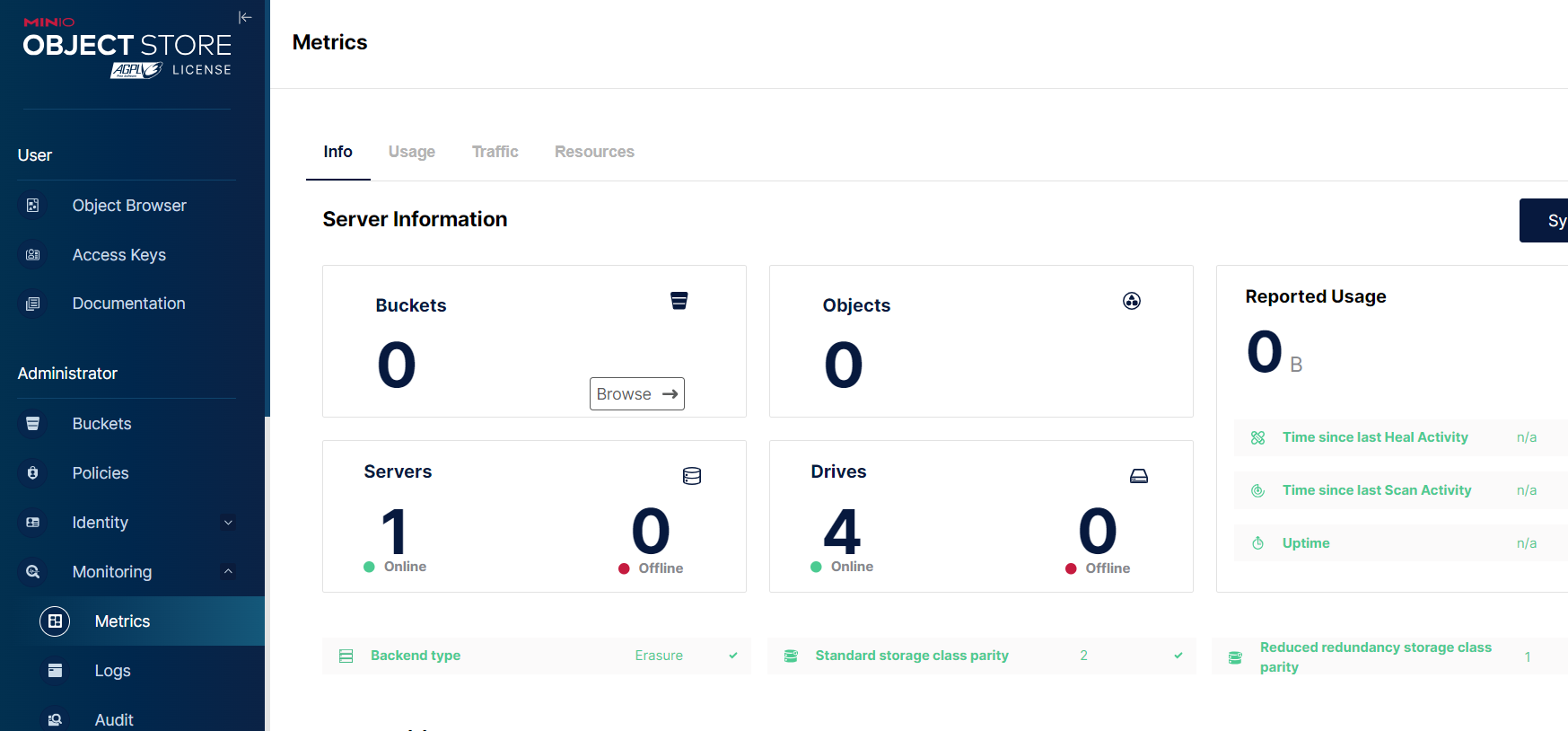
6)客户端工具 mc
wget https://dl.min.io/client/mc/release/linux-amd64/mc
chmod +x mc
sudo mv mc /usr/local/bin/mc
配置
# mc alias set <ALIAS> <YOUR-MINIO-ENDPOINT> [YOUR-ACCESS-KEY] [YOUR-SECRET-KEY]
mc alias set local http://192.168.182.110:9000 myminioadmin myminioadmin
mc admin info local
# 创建桶
# 并创建bucket harbor
mc mb local/test
mc ls local

更多 mc 客户端命令操作可以参考官方文档:https://min.io/docs/minio/linux/reference/minio-mc.html
三、分布式集群部署(多主机、多硬盘模式)
1)磁盘初始化
mkfs.xfs /dev/sdb -L DISK1
mkfs.xfs /dev/sdc -L DISK2
mkfs.xfs /dev/sdd -L DISK3
mkfs.xfs /dev/sde -L DISK4
mkdir /data{1..4}
vi /etc/fstab
# <file system> <mount point> <type> <options> <dump> <pass>
LABEL=DISK1 /data1 xfs defaults,noatime 0 2
LABEL=DISK2 /data2 xfs defaults,noatime 0 2
LABEL=DISK3 /data3 xfs defaults,noatime 0 2
LABEL=DISK4 /data4 xfs defaults,noatime 0 2
-
file systemLabel就是分区的标签,在最初安装系统是填写的挂载点就是标签的名字。使用设备名(例如:/dev/sdb)和label及uuid作为标识的不同。这里使用的是lable。 -
mount point挂载目录。 -
type文件系统类型,包括xfs、ext2、ext3、ext4、reiserfs、nfs、vfat等。 -
options文件系统的参数,参数如下:Async/sync:设置是否为同步方式运行,默认为asyncauto/noauto:当执行mount -a的命令时,此文件系统是否被主动挂载。默认为autorw/ro:是否以以只读或者读写模式挂载exec/noexec:限制此文件系统内是否能够进行"执行"的操作user/nouser:是否允许用户使用mount命令挂载suid/nosuid:是否允许SUID的存在Usrquota:启动文件系统支持磁盘配额模式Grpquota:启动文件系统对群组磁盘配额模式的支持Defaults:同事具有rw,suid,dev,exec,auto,nouser,async等默认参数的设置
-
dump是一个用来作为备份的命令参数值解释如下:0代表不要做dump备份1代表要每天进行dump的操作2代表不定日期的进行dump操作
2)创建服务启动用户并设置磁盘属主
groupadd -r minio-user
useradd -M -r -g minio-user minio-user
chown minio-user:minio-user /data{1..4}
3)下载 minio 安装包
wget https://dl.min.io/server/minio/release/linux-amd64/archive/minio-20231025063325.0.0.x86_64.rpm -O minio.rpm
sudo yum install minio.rpm -y
4)修改配置
vi /etc/default/minio
# Set the hosts and volumes MinIO uses at startup
# The command uses MinIO expansion notation {x...y} to denote a
# sequential series.
#
# The following example covers four MinIO hosts
# with 4 drives each at the specified hostname and drive locations.
# The command includes the port that each MinIO server listens on
# (default 9000)
MINIO_VOLUMES="http://192.168.182.110:9000/data{1...4}/minio http://192.168.182.111:9000/data{1...4}/minio http://192.168.182.112:9000/data{1...4}/minio"
# Set all MinIO server options
#
# The following explicitly sets the MinIO Console listen address to
# port 9001 on all network interfaces. The default behavior is dynamic
# port selection.
MINIO_OPTS="--console-address :9001"
# Set the root username. This user has unrestricted permissions to
# perform S3 and administrative API operations on any resource in the
# deployment.
#
# Defer to your organizations requirements for superadmin user name.
MINIO_ROOT_USER=minioadmin
# Set the root password
#
# Use a long, random, unique string that meets your organizations
# requirements for passwords.
MINIO_ROOT_PASSWORD=minioadmin
# Set to the URL of the load balancer for the MinIO deployment
# This value *must* match across all MinIO servers. If you do
# not have a load balancer, set this value to to any *one* of the
# MinIO hosts in the deployment as a temporary measure.
MINIO_SERVER_URL="http://10.192.168.110:9000"
【注意】
MINIO_SERVER_URL值必须所有节点是一样的。
5)配置 systemctl 启动
vi /usr/lib/systemd/system/minio.service
[Unit]
Description=MinIO
Documentation=https://min.io/docs/minio/linux/index.html
Wants=network-online.target
After=network-online.target
AssertFileIsExecutable=/usr/local/bin/minio
[Service]
WorkingDirectory=/usr/local
User=minio-user
Group=minio-user
ProtectProc=invisible
EnvironmentFile=-/etc/default/minio
ExecStartPre=/bin/bash -c "if [ -z \"${MINIO_VOLUMES}\" ]; then echo \"Variable MINIO_VOLUMES not set in /etc/default/minio\"; exit 1; fi"
ExecStart=/usr/local/bin/minio server $MINIO_OPTS $MINIO_VOLUMES
# MinIO RELEASE.2023-05-04T21-44-30Z adds support for Type=notify (https://www.freedesktop.org/software/systemd/man/systemd.service.html#Type=)
# This may improve systemctl setups where other services use `After=minio.server`
# Uncomment the line to enable the functionality
# Type=notify
# Let systemd restart this service always
Restart=always
# Specifies the maximum file descriptor number that can be opened by this process
LimitNOFILE=65536
# Specifies the maximum number of threads this process can create
TasksMax=infinity
# Disable timeout logic and wait until process is stopped
TimeoutStopSec=infinity
SendSIGKILL=no
[Install]
WantedBy=multi-user.target
# Built for ${project.name}-${project.version} (${project.name})
启动服务
sudo systemctl daemon-reload
sudo systemctl start minio.service
sudo systemctl status minio.service
journalctl -f -u minio.service
# 从日志里可以看到访问入口地址,也可以看/var/log/messages

【温馨提示】如果需要加磁盘,必须先把这个这个目录删掉,要不然无法启动,
/data{1..4}/.minio.sys,报错:ERROR Unable to initialize backend: /data1 drive is already being used in another erasure deployment. (Number of drives specified: 5 but the number of drives found in the 1st drive's format.json: 4)
web 访问:
S3-API: http://192.168.182.110:9000- 管理后台 web 地址,Console: http://192.168.182.110:9001
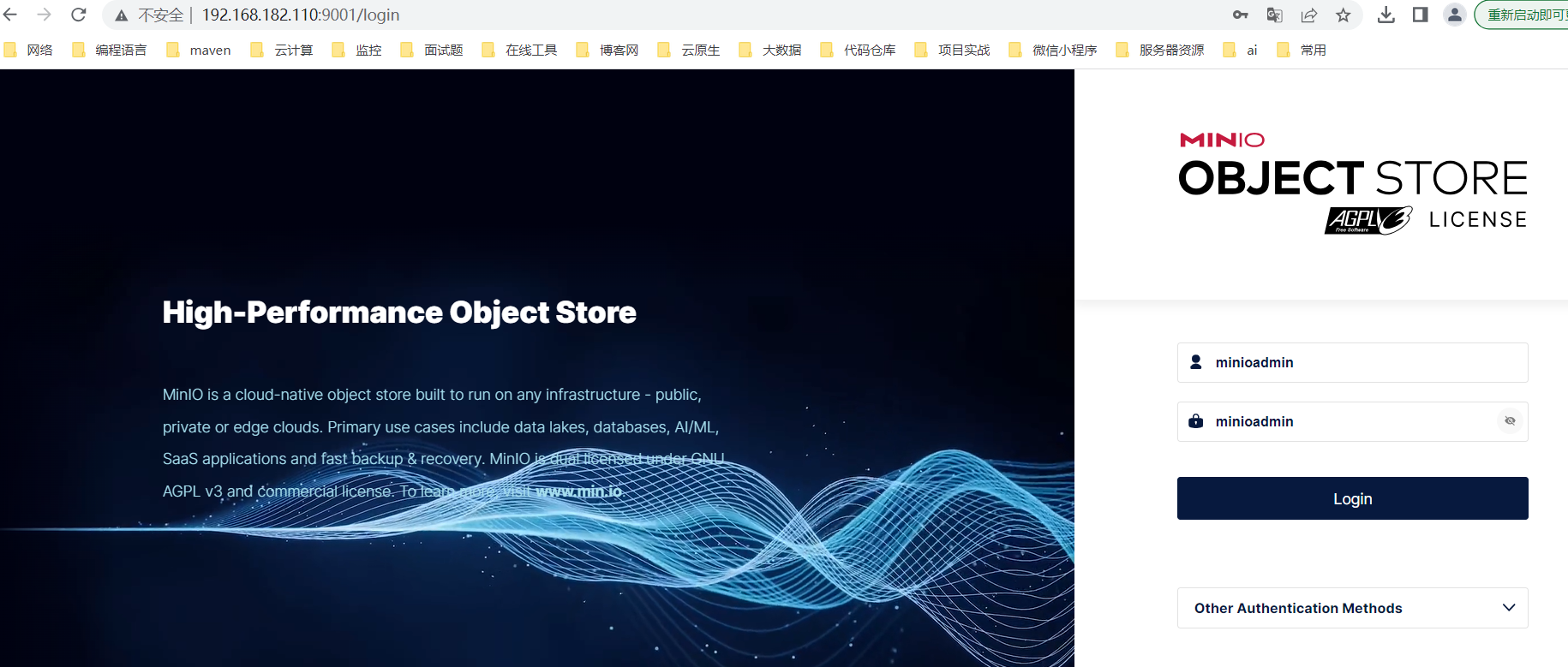
账号/密码:minioadmin/minioadmin
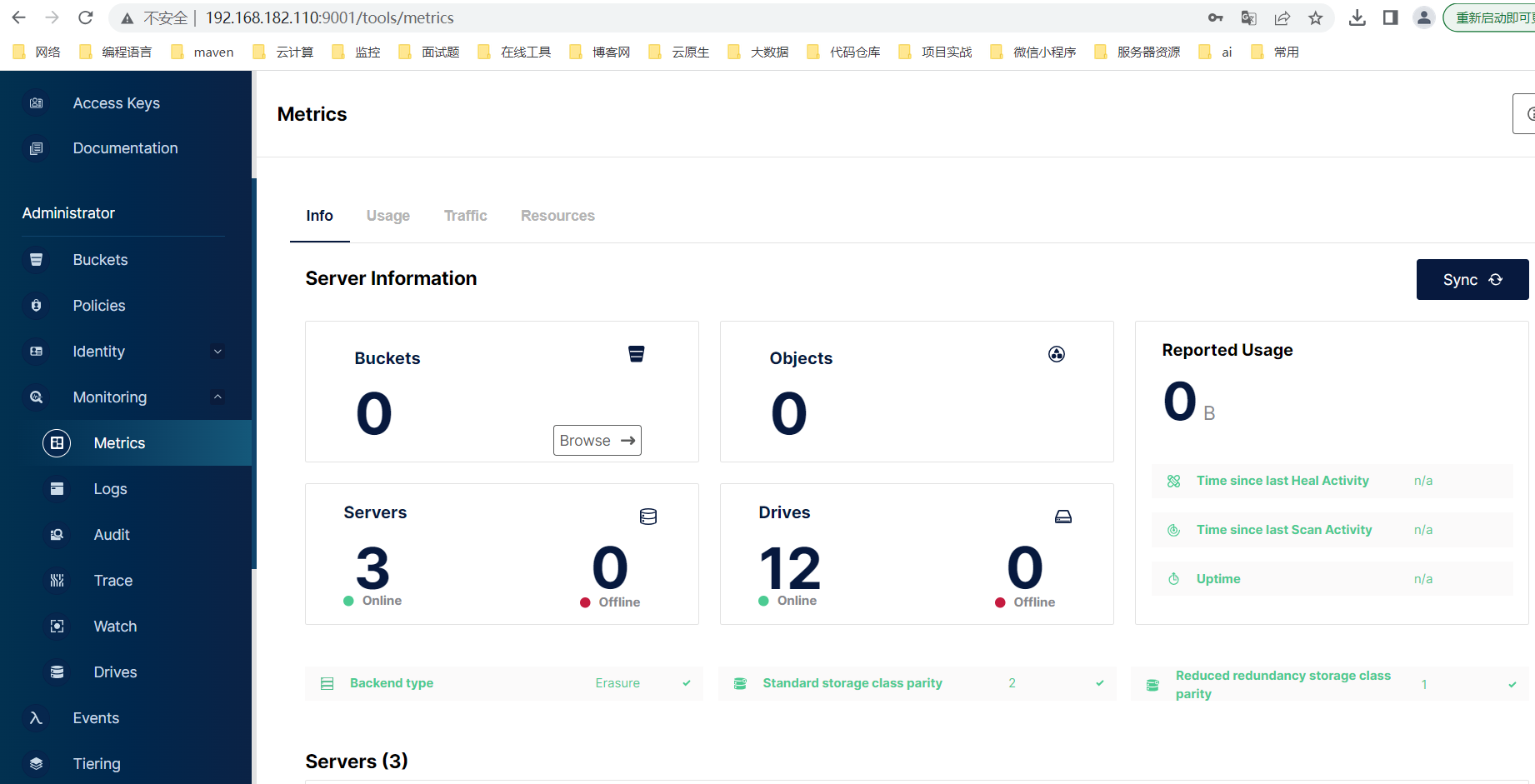
6)客户端工具 mc
wget https://dl.min.io/client/mc/release/linux-amd64/mc
chmod +x mc
sudo mv mc /usr/local/bin/mc
配置
# mc alias set <ALIAS> <YOUR-MINIO-ENDPOINT> [YOUR-ACCESS-KEY] [YOUR-SECRET-KEY]
mc alias set local http://192.168.182.110:9000 myminioadmin myminioadmin
mc admin info local
# 创建桶
# 并创建bucket harbor
mc mb local/test
mc ls local
更多 mc 客户端命令操作可以参考官方文档:https://min.io/docs/minio/linux/reference/minio-mc.html
MinIO 高性能分布式存储最新版单机与分布式部署就先到这里了,有任何疑问也可关注我公众号:大数据与云原生技术分享,进行技术交流,如本篇文章对您有所帮助,麻烦帮忙一键三连(点赞、转发、收藏)~

